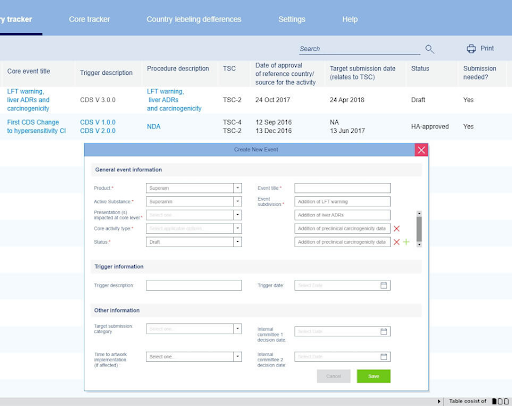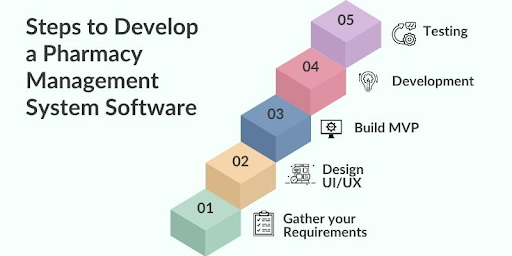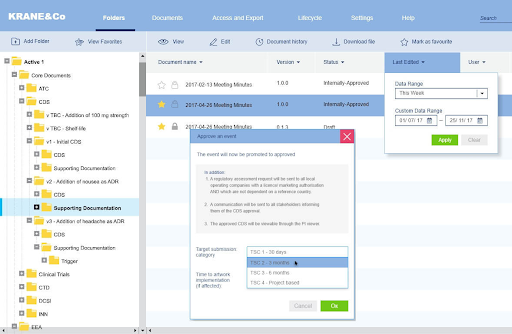How to Build Pharmacy Management Software: A Comprehensive Guide
In the fast-paced world of pharmaceuticals, managing inventory, dispensing medications, and keeping patient records can be daunting. Fortunately, technology has made it possible to automate many of these processes and improve the efficiency and accuracy of pharmaceutical operations.
Companies show interest in this area but often find it difficult to answer what tasks to set for them.
This article will explore the benefits of pharmacy management software and provide an overview of the software development process for companies interested in implementing this technology.
What Is A Pharmacy Management Software?
As the name suggests, a pharmacy management system, also known as a Pharmacy Information System (PIS), is a computerized system that stores, organizes and manages pharmacy data.
The software covers a variety of features, such as drug inventory management, prescription management, patient information management, drug information management and financial management.
It also includes features such as alerting and reporting, which can be used to improve patient safety and medication adherence.
How Pharmacy Management Software Helps Optimize Pharma Business
Pharmacy management software is an essential tool that helps optimize core pharmacy businesses by streamlining and automating various operations.
So how, exactly, can pharmacy automation help you to affect financial outcomes?
Here are the most common
- Reduce medication duplications and interactions. Pharmacists can quickly identify potential drug interactions, allergies, and duplications, preventing adverse drug events and improving patient safety.
- Improve patient care and drive healthier outcomes. By providing real-time access to patient information and medication histories, pharmacy management software enables pharmacists to provide more accurate and personalized care.
- Prevent medicine fraud. Pharmacy management software can help prevent medicine fraud by verifying patient identities, tracking prescription dispensing, and reducing the risk of counterfeit or expired medications.
- Expand your pharmacy with greater ease and flexibility. By automating key processes, such as adding new locations or services, prescriptions management, or integrating with an EHR system and providing real-time data, pharmacy management software can help businesses scale more efficiently and accurately.
- Monitor discharge patients and make recommendations for care. By tracking medications, monitoring patient progress and providing care recommendations, pharmacists can ensure that patients receive the appropriate care and that their medication regimens are followed.
Let’s go through the benefits so you can see them for yourself.
Who Should Implement the Pharmacy Management System?
- The PMS is suitable for individual pharmacy stores and a chain of pharmacy stores. Your chain may operate within the limits of a single municipality or span multiple cities or even states, with unique regulations and guidelines applicable to each store.
- The workflow at each store, whether individual or part of a chain, is quite similar as the same set of regulations governs them. The difference comes in analyzing the data at the individual or group level. PMS has extensive reporting and analytic capabilities for each business.
- Moreover, pharmacy management software (PMS) would enable you to effortlessly expand your chain by adding new stores, merging acquired stores, or even establishing a chain of stores starting from a single location. The store creation process is straightforward and economical compared to buying a new software license for each new store.
- In addition to retail stores, large client-base B2B companies dealing in drugs can also benefit from PMS by leveling up their relationships with their partners - pharmaceutical wholesalers and pharmaceutical manufacturing companies.
When is the Right Time to Deploy a Pharmacy Management System?
The right time to start something new and use something efficiently is always NOW. If you are already fed up with the inefficient, error-prone, and leaky system; if your customers get irritated because of the long queues and frequent complaints of medicine shortages; if your records, data, billing, and inventory management have gone out the window, then now is the right time for you.
As a pharmacist, you know that timely medication and treatment can be a game-changer. Similarly, the all-in-one medicine for all your business ailments is a feature-rich PMS that caters to your needs and is user-friendly. An efficient pharmacy management software can solve challenges such as:
- Pricing, billing, and payments.
- Medicine classification and choice.
- Stock ordering system.
- Pharmacy labeling and dispensing.
- POS integration.
- Insurance claim, credit, and cash balancing.
- Online pharmacy store management.
- Prescriptions, patient records, and document management.

Learn more...
Explore a detailed guide on creating an electronic document management system.
Benefits of Implementing Pharmacy Management Software
A properly customized pharmacy management system that serves all the needs of a pharmacy store can help achieve multiple goals simultaneously. You can deliver the highest level of personalized care, maximize profits, save costs, and comply with all regulations.
Some of the many benefits of a pharmacy management system are as follows.

Regulatory Compliance
Every aspect of a pharmaceutical business – manufacture, distribution, and sales – is governed by strict guidelines such as HIPPA, FDA, DEA, etc. So PMS should be easily customizable to meet the strict legal requirements of all major regulators and government agencies controlling the trade of drugs and medicines.
Our PMS also meets the standards set by many accreditation standards and regulators, including:
- NCPDP – National Council for Prescription Drug Program
- USP – United States Pharmacopeia
- HHS – The U.S. Department of Health and Human Services
- EMA – European Medicines Agency, European Union
- MHRA – Medicines and Healthcare products Regulatory Agency, UK
- HITECH -MU – HITECH’s Meaningful Use specifications
- HIPPA – Health Insurance Portability and Accountability Act
- HL7 -Health Level 7 International
- FDA21 – The Food and Drug Administration’s Title 21 CFR Part 11 rules.
These regulatory bodies require a pharmacy to send multiple reports in different formats and need direct access to your records. The PMS design can produce the desired reports and records and let a limited set of authorized users access the system for external audits.
Increase Sales
In addition to selling prescription medicines, a pharmacy store can sell many other related supplies and over-the-counter (OTC) medicines. Customers will visit your store if they can get all their requirements in one place.
A loyalty system can offer customers of your non-prescription articles an extra advantage in coming to your store, boosting your sales. You can open a loyalty program for all customers and let them win redeemable loyalty points on all their purchases.
Adapt New Business Model
You may be a walk-in pharmacy store or a fulfillment center for an online pharmacy. You may be dealing with end customers directly, or you may be dealing with other stores as a B2B business. Whatever your business model, you can start an added line of related business if you have our PMS for pharmacy management. Our strong foothold in the end-to-end value chain of pharmacy storage, distribution, and sales can benefit you in entering any of the segments you are not present in now.
More benefits:
- Economical and affordable solution.
- Increasing productivity of staff.
- Lesser errors mean lesser time spent on finding & fixing them.
- Flexible system customization to suit your requirements.
- A large number of modules for all processes & workflows.
- Separate user logins with differentiated rights and duties.
- Integrated barcode scanner for faster prescription reading and billing.
- Integrated POS module for faster checkout.
- Integrated delivery tracking, shipping, and order processing modules.
- Expiry date and minimum stock alerts.
- Detailed and summarized analysis report based on multiple parameters.
- Centralized & secure data storage system for easy retrieval by authorized users.
- User-friendly with intuitive UI design.
Must-Have Features of Custom Pharmacy Management Software
There are numerous advantages to using the Pharmacy Management System. It also has several features that are required for high-efficiency operations. The following are the most essential elements to add to your pharmacy management system software:
Inventory Management
Managing inventory is a very time-consuming and labor-intensive task for pharmacists, and there is no room for mistakes.
Due to paperwork, pharmacists spend up to 20% of their shifts dealing with inventory. This is not a very efficient way of doing business and wastes valuable time.
Pharmacy inventory management software can help pharmacists work more efficiently and accurately by providing various useful features. These include:
- Data-driven decisions in the medical drug supply chain and stock management to make informed decisions about inventory management.
- Automatically update stock data when incoming/outgoing transactions.
- Control medication stock through a specific product title and location/branch.
- Generating purchase orders to refill stock and automatically forwarding them to medical drug vendors/suppliers.
- Generate notifications/alerts when the pharmacy is close to exhausting its stock of specific medications.
- Build custom analytical reports that provide valuable insights into stock levels and projections, best-performing product titles, sales vs. supplies tracking and planning, AI-backed suggestions on pharma acquisition policy, and much more. These practices can be further enhanced by applying data mining methods in healthcare.
The pharmacy management system with inventory management sanctions assists in making data-driven decisions for updating drug varieties, selecting the most popular ones, handling stock supplies, placing timely orders, refilling prescriptions, recording prescription filling, and monitoring unauthorized and obsolete medicines.
Document and Data Management
Pharmacies generate a lot of data and electronic documents in their daily operations. Developing an online pharmacy management system allows you to optimize document workflows and improve document digitization and management processes.
Here are some ways that a document management solution can improve pharmaceutical document circulation:
- Enable scanning, storing, and retrieval of pharmacy documents.
- Import medical notes from physicians or pharmacists through a scanning device or manual input.
- Systematize patient health and medication profile data through an EHR/EMR-connected solution.
- Optimize e-prescription management to organize prescription services and maintain optimal stock levels.
- Streamline prescription refill processes to reduce incoming calls, enhance deliveries, and process more prescriptions.
- Improve billing and invoice workflows for interactions between pharmacies, suppliers, insurance providers, and patients seeking reimbursements.
Dispensation Workflow Management
Dispensation software can make the process of pharmaceutical dispensation much more efficient and streamlined by:
- Helping pharmacists access patient profiles quickly, verify insurance information, and check for drug interactions, allergies, or contraindications. The software can also streamline prescription refills by allowing patients to request them online.
- Verifying prescriptions against patient profiles, drug databases, and insurance information reduces the likelihood of errors. It can also provide alerts for potential drug interactions, allergies, or contraindications.
- Allowing pharmacies to identify medication synchronization candidates and patients who take multiple medications on different schedules by integrating with electronic health records (EHR) to access and manage patient records.
- Generating patient medication reports, which can be used to improve CMS Five Star ratings.
- Verifying insurance information, checking for drug coverage and formularies and submitting claims electronically.
Analytics & Dashboards
The user management module is another important aspect of the pharmacy management system. It enables pharmacists to set access restrictions for distinct user groups. The goal of adding this module is to allow users to reserve features for easier management. Authentication can indeed be applied in a variety of situations. The administrator user, for example, can handle the listing of medicines, stock monitoring, and other activities.

Learn more...
Elevate your insights into SaaS business intelligence with our SaaS Business Intelligence guide.
Pricing Management
This feature greatly simplifies the work in the case of invoicing for bulk purchases or when it comes time to change the prices of goods.
Integrations
Despite custom development, modern applications include third-party services, for example, to implement purchase payment. And the quality of work in your system depends on how such services are configured. We advise you to trust only reliable and trusted partners.
Custom Pharmacy Management System vs. Ready-Made Solutions
Ardas is an excellent choice for pharmacy management software development. We have the skills and years of professional experience to achieve exactly what our clients and their end-users want. We are dedicated to developing top-of-the-line, high-quality, cost-effective pharmacy management systems.
On the other hand, you can use ready-made solutions, but you must understand that, in this case, the functionality will not be as flexible, and in the end, you will have to give up some of your requirements. In addition, the use of ready-made systems of high quality is quite expensive. In this case, it is better to consider the option of a custom system that will belong entirely to you.
When to Choose Generic/Ready-made Pharmacy Software
- You are a small business (like an independent pharmacy) with typical business processes and no need for a large database.
- You don’t have sufficient resources to invest in the development of a custom pharmacy system (the cost of custom software development is pretty high.)
- You can try multiple solutions from different vendors before discovering the best package for your needs.
When to Opt for Custom Pharmacy Management Software
- Your business is at least mid-sized, and you consider a custom software investment worthwhile.
- You have specific business processes that cannot be facilitated with the help of existing readymade software.
- You want control over every element of your software, including security factors, to make sure none of your business data can ever be hijacked.
- You want to scale up your business without being held back by limitations.
How to Develop Pharmacy Management Software
Follow the below-mentioned points to build the best pharmacy management software:

Step 1: Gather Requirements For Your Pharmacy Solution
This step focuses on developing, gathering, and assessing the software product’s requirements. This usually entails exploring:
- Who will be your end-users?
- What features do you want in your online pharmacy management system software?
- What problem do you want to solve?
- What technologies do you want to use?
The feasibility of combining the pieces into the final product is reviewed and carefully studied once you have the solutions to these questions.
Step 2: Design UI/UX
Once the requirement analysis is finished, a blueprint of the entire system is created. Design encompasses not only the appearance of the software but also its general functionality and user experience. At this point, teams may use fast prototyping to test alternative concepts and discover the best match.
When the design is complete, you should study it and gain feedback and ideas from other individuals.
Step 3: Build MVP
A minimum viable product (MVP) is a tried-and-true technique for launching a new product. It is widely used not only by start-ups but also by well-established businesses.
MVP is the most vital step in the development process. With their project, companies frequently have anticipated targets and conditional expectations. MVP enables a full-scale test of the product in its simplest form in real-world market circumstances. It will allow you to test, experiment, and evaluate how well your product engages with your target audience. It also aids in the measurement of user interaction, with a focus on ultimate goals and desires.
The best and safest approach to developing and launching a new product is to start with an MVP. Using MVP, businesses can reduce the difficulties and dangers of investing in the wrong concept or going over budget.
Step 4: Development of Pharmacy Management Software
This pharmacy management software development stage begins only after everyone has agreed on the specifications, design, and features. The healthcare developers begin programming after the development team has the specifications and design papers in hand. The developers who work on putting the idea to reality carry out this phase. This is the phase in the software development life cycle where the real solution is created, and it is by far the longest.
The pharmacy management system development process should be simple if you follow the previous procedures correctly!
Step 5: Testing
Once the development is complete, it must be tested against the specifications to confirm that the software product answers the end user’s problem.
You can expect a variety of functional testing during this phase, including integration testing, test automation, system testing, acceptance testing, design implementation testing, and more.
This procedure is required because it is critical to test the product thoroughly against all accessible parameters. The testing step reveals the product’s potential problems, which are then fixed if necessary.
Technology Stack for Pharmacy Management Software
We always use the best tech stack for SaaS, so the technology stack for PMS is highly efficient and used by the best developers to build secure apps and web applications.
- Front End: Angular, HTML, CSS, React, Kotlin/Java, Swift
- Back End: Node.js, Laravel, Python
- Payment Gateway: All leading including PayPal API, Stripe API, Credit cards
- Location Tracking: MapKit Framework, Google Maps, Radar.io
- Notifications: Push notifications, SMS, In-app messaging, email alerts
- Database: PostgreSQL, MongoDB, MySQL, Redis
- Analytics: Google Analytics, Apache Spark, rapid miner
- Mobile App: Swift for iOS app, Kotlin/Java for Android
- Cloud Host: AWS, Google Cloud, Azure
- Social Login: Google, Facebook, Twitter, LinkedIn, etc.
Cost To Build
Development of a custom pharmacy management system can be a pretty expensive undertaking, with prices ranging from $30-40k to unlimited heights (starting at three months of project duration). It all depends on the complexity of the software design and implementation.
We wrote the whole article on the cost of SaaS product where you can learn more. However, the price tag is critically affected by the following factors:
- Number and skill set of IT specialists involved: different types of developers, testers, UI/UX designers, project manager(s), and others
- The complexity of the project’s technology stack (platforms, languages, and framework)
- The team members' location is U.S.-based or remote, outsourced or full-time/in-house.
The cost to develop a scalable solution depends on the following factors:
- Integration of ERP and CRM modules
- Third-party API integrations
- Robotics/hardware integrations
- Mobile app development
- Desktop and/or web application development
- Data migration charges
- Maintenance and support.
The cost of the software can be calculated with a proxy by the cost of the technical man-hours devoted to developing the solution.
A team made up of a Project manager, mobile app developers, database & cloud engineers, UI/UX engineers, quality assurance & testing engineers, and data migration engineers will be devoted to the project. We expect they will need between 625 to 700 man-hours.
Pharmaceutical Document Management SaaS [Case Study]
Our team has been working on creating systems for pharmaceutical companies for more than ten years. One of these collaborations began in 2014 and continues to this day.
Our client wanted to create the only pharmaceutical document management system that handles everything that happens with pharmaceutical documents within their endless life cycle. Pharmaceutical production companies use a combination of CRM, ERP, and document applications that are poorly integrated and not optimized for pharmaceutical specifics. Using them is difficult, they are very slow and non-intuitive. Alternatives are either unusable or cost a lot.
The biggest part of employees in the pharmaceutical industry who manage document changes is 50+ years old. They still use and like standalone applications of the previous age and don't recognize modern web UX standards. They use an older version of MS Windows and don't update them. We created a web application that utilizes MS Windows UI style and all their favorite UX components such as trees, tables, etc. They accepted UI and workflow we created.

The goal was to develop a system that would horizontally pierce the whole manufacturing process and handle every stage, task, and state of any document, minimizing human labor and hassles. We studied the full document flow and every employee's job and completely redesigned this process. We made it dedicated and optimized for pharmaceutical needs.
The new solution was used for one of our early adopters in the UK. We helped this company migrate all their documents and data into the new platform while polishing it and implementing employee feedback. Stabilizing MVP and shifting all employees to the new principles took six months. This system awaits more investments now to proceed with development and sales.
Among other features that we have mentioned above, we implemented:
Document Storage and Management
We have developed a database and storage for files and documents related to pharmaceutical products. During the development and life of a pharmaceutical product, the documentation is regularly updated, new ones appear, and all records are unique for each product. Consequently, this requires a lot of storage space.
From our side, we did everything from planning to implementation. The application provides an interface that allows you to access any of the files and watch all changes in the product development process.
Version Control and Tracking
Each pharmaceutical product document has a large number of versions. This is because everything in this document must undergo a certain verification by various medical structures. Because of this, a large number of versions arise.
We have developed a version structure specifically for pharmaceutical documentation since it differs greatly from other industries. Documentation change control is carried out using an interface where you can track the entire history.
Approval Process
We have solved the problem of updating the confirmation process of pharmaceutical products since the standard CRM systems are not adapted to this unique process.
We have set up all the accounting for this process, including discussions, comments between the agents of this process, status updates, and the appointment of those responsible for the implementation of this process.
You can also check our case study about developing drugstore software.
Final Thoughts
Any software system is as good as it is used, and with the right inputs from your side, we are certain that Ardas' expert team can meet and exceed all your requirements. We strive to deliver the right fit to match your needs for today while keeping enough scope in the system to handle the increased pressures of tomorrow.
With the 24×7 support that the Ardas team can offer, nothing can go wrong, and even if it does, we can fix it in no time. Then what are you waiting for? Fill out the form below and fill in your query so our custom medical software expert can connect with you and gather your requirements.
